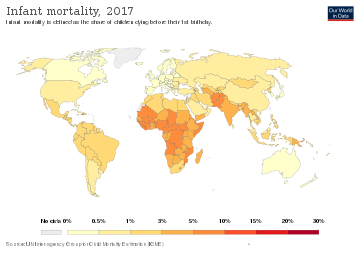嬰兒死亡率

嬰兒死亡率(英語:infant mortality rate,縮寫為IMR)是指每1000名活產兒中在一歲前死亡的人口數[1][2][與來源不符]。這個比率是衡量一個國家健康水平的指標。由於嬰兒死亡率只統計一歲以下的數據, 而統計五歲以下兒童死亡的兒童死亡率也是一個重要的統計數據[3]。
2013年時,美國嬰兒死亡死因的第一名是先天缺陷[4]。其他的死因有出生窒息、肺炎、先天性障礙、足月分娩併發症(例如臍帶脫垂或是滯產[5]、新生兒感染、腹瀉、瘧疾、麻疹及營養不良[6]。)嬰兒死亡死因中,最常見可預防的原因是孕婦在懷孕時吸菸[7]。沒有產前檢查、孕婦在懷孕時飲酒或是管制藥物使用也可能會導致併發症,造成嬰兒死亡[8][與來源不符]。許多環境因素會影響嬰兒死亡率,例如母親的教育程度、環境因素、政治以及醫療上的基礎建設[9]。改善衛生設施、讓大家可以取得潔淨的飲用水、提昇對感染性疾病的免疫,以及其他公共衛生措施都有助於降低嬰兒死亡率。
2018年的報告給出的世界平均嬰兒死亡率為千分之30。[10] 而五歲以下兒童死亡率為千分之39。 跟1990年相比已有很好的改善。[11]
統計
[編輯]
前十大高嬰兒死亡率的國家有:
 安哥拉 192.50
安哥拉 192.50 阿富汗 165.96
阿富汗 165.96 獅子山 145.24
獅子山 145.24 莫三比克 137.08
莫三比克 137.08 賴比瑞亞 130.51
賴比瑞亞 130.51 尼日 122.66
尼日 122.66 索馬利亞 118.52
索馬利亞 118.52 馬利 117.99
馬利 117.99 塔吉克 112.10
塔吉克 112.10 幾內亞比索 108.72
幾內亞比索 108.72
嬰幼兒死亡率和平均壽命的關係
[編輯]古代嬰幼兒死亡率高,是古代平均壽命低的主要原因,像例如說在十三世紀時,英國貴族的平均壽命大約是30歲。但當時,對於活到21歲的成年男性而言,他們依舊能預期活到大約62至70歲左右。[12][13]嬰幼兒死亡率的巨幅下降,是20世紀中期以前平均壽命增長的最可能的原因(然而二十世紀中期後平均壽命增加的主要原因變為老年人壽命增加)。[14]因此有理由認為所謂的古代人「平均壽命都不超過50歲」,因為「很多人在30-40歲的青壯年期間因為戰亂或疾病而離世」之類的說法,是錯誤的;然而應當注意的是,有時也會出現人們平均壽命與實際死亡的壽命差不多的狀況,像例如曾有人對古羅馬遺址做研究,結果發現古羅馬勞工階級的死亡壽命大多在30歲左右。[13]
參考文獻
[編輯]- ^ Mathews TJ, MacDorman MF. Infant mortality statistics from the 2009 period linked birth/infant death data set (PDF). National Vital Statistics Reports. January 2013, 61 (8): 1–27 [2020-08-25]. PMID 24979974. (原始內容存檔 (PDF)於2020-11-15).
- ^ Indicator Metadata Registry Details. www.who.int. [2020-07-29]. (原始內容存檔於2021-01-15) (英語).
- ^ Under-Five Mortality. UNICEF. [2017-03-07]. (原始內容存檔於2020-04-23).
- ^ Mathews TJ, MacDorman MF, Menacker F. Infant mortality statistics from the 1999 period linked birth/infant death data set (PDF). National Vital Statistics Reports. January 2002, 50 (4): 1–28 [2020-08-25]. PMID 11837053. doi:10.1037/e558952006-001. hdl:1903/24216. (原始內容存檔 (PDF)於2021-03-09).
- ^ Labor and Delivery Complications -- the Basics. WebMD. [2017-03-16]. (原始內容存檔於2019-01-30).
- ^ Infant Mortality & Newborn Health. Women and Children First. [2017-04-25]. (原始內容存檔於2019-12-10).
- ^ Hall ES, Venkatesh M, Greenberg JM. A population study of first and subsequent pregnancy smoking behaviors in Ohio. Journal of Perinatology. November 2016, 36 (11): 948–953. PMID 27467563. S2CID 29303225. doi:10.1038/jp.2016.119.
- ^ CDC. Commit to Healthy Choices to Help Prevent Birth Defects | CDC. Centers for Disease Control and Prevention. 2020-06-03 [2020-07-30]. (原始內容存檔於2021-03-04) (美國英語).
- ^ Genowska A, Jamiołkowski J, Szafraniec K, Stepaniak U, Szpak A, Pająk A. Environmental and socio-economic determinants of infant mortality in Poland: an ecological study. Environmental Health. July 2015, 14: 61. PMC 4508882
 . PMID 26195213. doi:10.1186/s12940-015-0048-1.
. PMID 26195213. doi:10.1186/s12940-015-0048-1.
- ^ UN Inter-agency Group for Child Mortality Estimation. CHILD SURVIVAL: KEY FACTS AND FIGURES (PDF). Levels & Trends in Child Mortality. 2018, (Report 2018): 2 [2019-09-13]. (原始內容 (PDF)存檔於2020-02-08).
- ^ Levels and Trends in Child Mortality Report 2018 | United Nations Population Division | Department of Economic and Social Affairs. www.un.org. [2019-09-13]. (原始內容存檔於2021-03-08) (英語).
- ^ Lancaster, H. O. Expectations of life : a study in the demography, statistics, and history of world mortality. New York: Springer-Verlag. 1990: 8. ISBN 9781461210030.
- ^ 13.0 13.1 Amanda Ruggeri. Do we really live longer than our ancestors?. BBC. BBC. 2018-10-03 [2023-01-10]. (原始內容存檔於2023-03-21).
- ^ How has life expectancy changed over time?. Office for National Statistics. [2023-01-10]. (原始內容存檔於2023-03-28).
